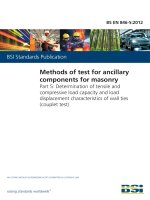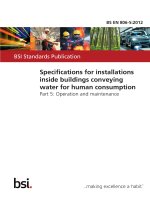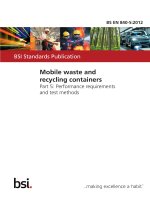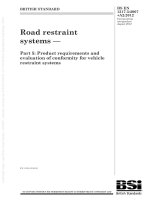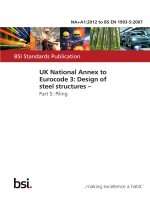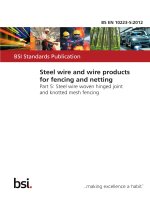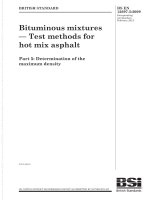Bsi bs en 61158 5 15 2012
Bạn đang xem bản rút gọn của tài liệu. Xem và tải ngay bản đầy đủ của tài liệu tại đây (1.67 MB, 144 trang )
BS EN 61158-5-15:2012
BSI Standards Publication
Industrial communication
networks — Fieldbus
specifications
Part 5-15: Application layer service
definition — Type 15 elements
BS EN 61158-5-15:2012 BRITISH STANDARD
National foreword
This British Standard is the UK implementation of EN 61158-5-15:2012. It is
identical to IEC 61158-5-15:2010. It supersedes BS EN 61158-5-15:2008,
which is withdrawn.
The UK participation in its preparation was entrusted to Technical Committee
AMT/7, Industrial communications: process measurement and control,
including fieldbus.
A list of organizations represented on this committee can be obtained on
request to its secretary.
This publication does not purport to include all the necessary provisions of a
contract. Users are responsible for its correct application.
© The British Standards Institution 2012
Published by BSI Standards Limited 2012
ISBN 978 0 580 71557 0
ICS 25.040.40; 35.100.70; 35.110
Compliance with a British Standard cannot confer immunity from
legal obligations.
This British Standard was published under the authority of the Standards
Policy and Strategy Committee on 31 July 2012.
Amendments issued since publication
Date Text affected
EUROPEAN STANDARD BS EN 61158-5-15:2012
NORME EUROPÉENNE
EUROPÄISCHE NORM EN 61158-5-15
ICS 25.040.40; 35.100.70; 35.110 June 2012 Supersedes EN 61158-5-15:2008
English version
Industrial communication networks -
Fieldbus specifications -
Part 5-15: Application layer service definition -
Type 15 elements
(IEC 61158-5-15:2010)
Réseaux de communication industriels - Industrielle Kommunikationsnetze -
Spécifications des bus de terrain - Feldbusse -
Partie 5-15: Définition des services des Teil 5-15: Dienstfestlegungen des
couches d'application - Application Layer (Anwendungsschicht) -
Eléments de type 15 Typ 15-Elemente
(CEI 61158-5-15:2010) (IEC 61158-5-15:2010)
This European Standard was approved by CENELEC on 2012-03-28. CENELEC members are bound to comply
with the CEN/CENELEC Internal Regulations which stipulate the conditions for giving this European Standard
the status of a national standard without any alteration.
Up-to-date lists and bibliographical references concerning such national standards may be obtained on
application to the CEN-CENELEC Management Centre or to any CENELEC member.
This European Standard exists in three official versions (English, French, German). A version in any other
language made by translation under the responsibility of a CENELEC member into its own language and notified
to the CEN-CENELEC Management Centre has the same status as the official versions.
CENELEC members are the national electrotechnical committees of Austria, Belgium, Bulgaria, Croatia, Cyprus,
the Czech Republic, Denmark, Estonia, Finland, France, Germany, Greece, Hungary, Iceland, Ireland, Italy,
Latvia, Lithuania, Luxembourg, Malta, the Netherlands, Norway, Poland, Portugal, Romania, Slovakia, Slovenia,
Spain, Sweden, Switzerland, Turkey and the United Kingdom.
CENELEC
European Committee for Electrotechnical Standardization
Comité Européen de Normalisation Electrotechnique
Europäisches Komitee für Elektrotechnische Normung
Management Centre: Avenue Marnix 17, B - 1000 Brussels
© 2012 CENELEC - All rights of exploitation in any form and by any means reserved worldwide for CENELEC members.
Ref. No. EN 61158-5-15:2012 E
BS EN 61158-5-15:2012
EN 61158-5-15:2012 - 2 -
Foreword
The text of document 65C/606/FDIS, future edition 2 of IEC 61158-5-15, prepared by SC 65C, "Industrial
networks", of IEC/TC 65, "Industrial-process measurement, control and automation" was submitted to the
IEC-CENELEC parallel vote and approved by CENELEC as EN 61158-5-15:2012.
The following dates are fixed: (dop) 2012-12-28
(dow) 2015-03-28
• latest date by which the document has
to be implemented at national level by
publication of an identical national
standard or by endorsement
• latest date by which the national
standards conflicting with the
document have to be withdrawn
This document supersedes EN 61158-5-15:2008.
EN 61158-5-15:2012 includes the following significant technical change with respect to EN 61158-5-
15:2008:
— editorial corrections.
Attention is drawn to the possibility that some of the elements of this document may be the subject of
patent rights. CENELEC [and/or CEN] shall not be held responsible for identifying any or all such patent
rights.
Endorsement notice
The text of the International Standard IEC 61158-5-15:2010 was approved by CENELEC as a European
Standard without any modification.
BS EN 61158-5-15:2012
- 3 - EN 61158-5-15:2012
Annex ZA
(normative)
Normative references to international publications
with their corresponding European publications
The following documents, in whole or in part, are normatively referenced in this document and are
indispensable for its application. For dated references, only the edition cited applies. For undated
references, the latest edition of the referenced document (including any amendments) applies.
NOTE When an international publication has been modified by common modifications, indicated by (mod), the relevant EN/HD
applies.
Publication Year Title EN/HD Year
IEC/TR 61158-1 2010 2010
Industrial communication networks - Fieldbus CLC/TR 61158-1
IEC 61158-6-15 2010 specifications - 2012
Part 1: Overview and guidance for the EN 61158-6-15
ISO/IEC 7498-1 - IEC 61158 and IEC 61784 series -
ISO/IEC 8822 - - -
ISO/IEC 8824-1 - Industrial communication networks - Fieldbus - -
ISO/IEC 9545 - specifications - - -
ISO/IEC 10731 - Part 6-15: Application layer protocol - -
specification - Type 15 elements -
Information technology - Open Systems
Interconnection - Basic Reference Model:
The Basic Model
Information technology - Open Systems
Interconnection - Presentation service
definition
Information technology - Abstract Syntax
Notation One (ASN.1): Specification of basic
notation
Information technology - Open Systems
Interconnection - Application Layer structure
Information technology - Open Systems
Interconnection - Basic reference model -
Conventions for the definition of OSI services
– 2 – BS EN 61158-5-15:2012
61158-5-15 © IEC:2010(E)
CONTENTS
INTRODUCTION ..................................................................................................................... 7
1 Scope...............................................................................................................................8
1.1 Overview .................................................................................................................8
1.2 Specifications..........................................................................................................9
1.3 Conformance...........................................................................................................9
1.4 Type overview .......................................................................................................10
2 Normative references .....................................................................................................10
3 Terms and definitions, abbreviations, symbols and conventions ..................................... 11
3.1 Terms and definitions ............................................................................................11
3.2 Abbreviations and symbols .................................................................................... 19
3.3 Conventions ..........................................................................................................20
4 Concepts ........................................................................................................................ 23
4.1 Common concepts.................................................................................................23
4.2 Client/server specific concepts ..............................................................................23
4.3 Publish/subscribe specific concepts ......................................................................32
5 Data type ASE................................................................................................................41
5.1 General .................................................................................................................41
5.2 Formal definition of data type objects .................................................................... 41
5.3 FAL defined data types..........................................................................................41
5.4 Data type ASE service specification ...................................................................... 54
6 Client/server communication model specification ............................................................54
6.1 ASEs .....................................................................................................................54
6.2 ARs ..................................................................................................................... 113
6.3 Summary of FAL classes ..................................................................................... 116
6.4 Permitted FAL services by AREP role.................................................................. 116
7 Publish/subscribe communication model specification .................................................. 118
7.1 ASEs ................................................................................................................... 118
7.2 ARs ..................................................................................................................... 137
7.3 Summary of FAL classes ..................................................................................... 139
7.4 Permitted FAL services by AREP role and sub-role ............................................. 139
Bibliography........................................................................................................................ 140
Figure 1 – Client/server stacks..............................................................................................24
Figure 2 – Client/server communication on different buses or networks ................................ 24
Figure 3 – Client/server APOs services conveyed by the FAL ............................................... 25
Figure 4 – Interpretation as distinct tables ............................................................................26
Figure 5 – Interpretation as overlapping tables .....................................................................27
Figure 6 – APO and real objects, non obvious possible interpretation ................................... 27
Figure 7 – ASE service conveyance ...................................................................................... 29
Figure 8 – Client/server confirmed interaction .......................................................................30
Figure 9 – Client/server AR confirmed service primitives (positive case) ............................... 31
Figure 10 – Client/server AR confirmed service primitives (negative case)............................ 31
Figure 11 – Client/server unconfirmed interaction .................................................................32
BS EN 61158-5-15:2012 – 3 –
61158-5-15 © IEC:2010(E)
Figure 12 – Client/server AR unconfirmed service primitives ................................................. 32
Figure 13 – Publish/subscribe communications stacks ..........................................................33
Figure 14 – Publish/subscribe data-centric exchanges between decoupled network
objects .................................................................................................................................. 34
Figure 15 – Publish/subscribe APOs services conveyed by the FAL...................................... 35
Figure 16 – Examples of publish/subscribe configurable behaviors via QoS......................... 36
Figure 17 – Pull model interactions .......................................................................................38
Figure 18 – Push model interactions .....................................................................................39
Figure 19 – Publish/subscribe model interactions.................................................................. 40
Figure 20 – Status bit sequence numbering .......................................................................... 44
Figure 21 – ObjectId ............................................................................................................. 48
Figure 22 – Bitmap ............................................................................................................... 52
Figure 23 – ParameterSequence...........................................................................................54
Figure 24 – FAL ASEs ..........................................................................................................55
Figure 25 – Client/server encapsulated interface mechanism .............................................. 102
Figure 26 – Publish/subscribe class derivations and relationships....................................... 118
Figure 27 – FAL ASEs and classes ..................................................................................... 119
Figure 28 – Publish/subscribe service request composition................................................. 129
Table 1 – Common client/server APOs..................................................................................25
Table 2 – Class identification ................................................................................................49
Table 3 – Assigned vendor IDs .............................................................................................50
Table 4 – Bitmap “1234/12:00110” ........................................................................................53
Table 5 – Filter service parameters .......................................................................................58
Table 6 – Read discretes service parameters........................................................................60
Table 7 – Read coils service parameters ..............................................................................63
Table 8 – Write single coil service parameters ...................................................................... 65
Table 9 – Write multiple coils service parameters ................................................................. 66
Table 10 – Broadcast write single coil service parameters .................................................... 68
Table 11 – Broadcast write multiple coils service parameters................................................ 69
Table 12 – Read input registers service parameters.............................................................. 71
Table 13 – Read holding registers service parameters .......................................................... 76
Table 14 – Write single holding register service parameters.................................................. 78
Table 15 – Write multiple holding registers service parameters ............................................. 79
Table 16 – Mask write holding register service parameters ................................................... 81
Table 17 – Read/write holding registers service parameters ................................................. 83
Table 18 – Read FIFO service parameters............................................................................85
Table 19 – Broadcast write single holding register service parameters.................................. 86
Table 20 – Broadcast write multiple holding registers service parameters ............................. 87
Table 21 – Read file service parameters ...............................................................................94
Table 22 – Write file service parameters ...............................................................................98
Table 23 – Device identification categories ......................................................................... 104
Table 24 – Read device ID code ......................................................................................... 105
– 4 – BS EN 61158-5-15:2012
61158-5-15 © IEC:2010(E)
Table 25 – Conformity level ................................................................................................ 106
Table 26 – Requested vs. returned known objects .............................................................. 107
Table 27 – Read device identification service parameters ................................................... 109
Table 28 – FAL class summary ........................................................................................... 116
Table 29 – Services by AREP role ...................................................................................... 117
Table 30 – Issue service parameters .................................................................................. 121
Table 31 – Heartbeat service parameters............................................................................ 122
Table 32 – VAR service parameters .................................................................................... 124
Table 33 – VAR service parameters .................................................................................... 126
Table 34 – ACK service parameters .................................................................................... 128
Table 35 – Header service parameters ............................................................................... 131
Table 36 – INFO_DST service parameters .......................................................................... 132
Table 37 – INFO_REPLY service parameters...................................................................... 133
Table 38 – INFO_SRC service parameters.......................................................................... 135
Table 39 – INFO_TS service parameters ............................................................................ 136
Table 40 – PAD service parameters .................................................................................... 137
Table 41 – FAL class summary ........................................................................................... 139
Table 42 – Services by AREP role and sub-role .................................................................. 139
BS EN 61158-5-15:2012 – 7 –
61158-5-15 © IEC:2010(E)
INTRODUCTION
This part of IEC 61158 is one of a series produced to facilitate the interconnection of
automation system components. It is related to other standards in the set as defined by the
“three-layer” fieldbus reference model described in IEC/TR 61158-1.
The application service is provided by the application protocol making use of the services
available from the data-link or other immediately lower layer. This standard defines the
application service characteristics that fieldbus applications and/or system management may
exploit.
Throughout the set of fieldbus standards, the term “service” refers to the abstract capability
provided by one layer of the OSI Basic Reference Model to the layer immediately above.
Thus, the application layer service defined in this standard is a conceptual architectural
service, independent of administrative and implementation divisions.
– 8 – BS EN 61158-5-15:2012
61158-5-15 © IEC:2010(E)
INDUSTRIAL COMMUNICATION NETWORKS –
FIELDBUS SPECIFICATIONS –
Part 5-15: Application layer service definition –
Type 15 elements
1 Scope
1.1 Overview
In network communications, as in many fields of engineering, it is a fact that “one size does
not fit all.” Engineering design is about making the right set of trade-offs, and these trade-offs
must balance conflicting requirements such as simplicity, generality, ease of use, richness of
features, performance, memory size and usage, scalability, determinism, and robustness.
These trade-offs must be made in light of the types of information flow (e.g. periodic, one-to-
many, request-reply, events), and the constraints imposed by the application and execution
platforms.
The Type 15 fieldbus provides two major communication mechanisms that complement each
others to satisfy communication requirements in the field of automation: the Client/Server and
the Publish/Subscribe paradigms. They can be used concurrently on the same device.
Type 15 Client/Server operates in a Client/Server relationship. Its application layer service
definitions and protocol specifications are independent of the underlying layers, and have
been implemented on a variety of stacks and communication media, including EIA/TIA-232,
EIA/TIA-422, EIA/TIA-425, HDLC (ISO 13239), fiber, TCP/IP, Wireless LANs and Radios.
Type 15 Publish/Subscribe operates in a Publish/Subscribe relationship. Its application layer
service definitions and protocol specifications are independent of the underlying layers and
can be configured to provide reliable behavior and support determinism. The most common
stack is UDP/IP.
The fieldbus application layer (FAL) provides user programs with a means to access the
fieldbus communication environment. In this respect, the FAL can be viewed as a “window
between corresponding application programs.”
This part of IEC 61158 provides common elements for basic time-critical and non-time-critical
messaging communications between application programs in an automation environment and
material specific to Type 15 fieldbus. The term “time-critical” is used to represent the
presence of a time-window, within which one or more specified actions are required to be
completed with some defined level of certainty. Failure to complete specified actions within
the time window risks failure of the applications requesting the actions, with attendant risk to
equipment, plant and possibly human life.
This part of IEC 61158 defines in an abstract way the externally visible service provided by
the Type 15 fieldbus application layer in terms of
a) an abstract model for defining application resources (objects) capable of being
manipulated by users via the use of the FAL service,
b) the primitive actions and events of the service;
c) the parameters associated with each primitive action and event, and the form which they
take; and
d) the interrelationship between these actions and events, and their valid sequences.
BS EN 61158-5-15:2012 – 9 –
61158-5-15 © IEC:2010(E)
The purpose of this part of IEC 61158 is to define the services provided to
a) the FAL user at the boundary between the user and the Application Layer of the Fieldbus
Reference Model, and
b) Systems Management at the boundary between the Application Layer and Systems
Management of the Fieldbus Reference Model.
This part of IEC 61158 specifies the structure and services of the Type 15 IEC fieldbus
Application Layer, in conformance with the OSI Basic Reference Model (ISO/IEC 7498-1) and
the OSI Application Layer Structure (ISO/IEC 9545).
FAL services and protocols are provided by FAL application-entities (AE) contained within the
application processes. The FAL AE is composed of a set of object-oriented Application
Service Elements (ASEs) and a Layer Management Entity (LME) that manages the AE. The
ASEs provide communication services that operate on a set of related application process
object (APO) classes. One of the FAL ASEs is a management ASE that provides a common
set of services for the management of the instances of FAL classes.
Although these services specify, from the perspective of applications, how request and
responses are issued and delivered, they do not include a specification of what the requesting
and responding applications are to do with them. That is, the behavioral aspects of the
applications are not specified; only a definition of what requests and responses they can
send/receive is specified. This permits greater flexibility to the FAL users in standardizing
such object behavior. In addition to these services, some supporting services are also defined
in this standard to provide access to the FAL to control certain aspects of its operation.
1.2 Specifications
The principal objective of this part of IEC 61158 is to specify the characteristics of conceptual
application layer services suitable for time-critical communications, and thus supplement the
OSI Basic Reference Model in guiding the development of application layer protocols for time-
critical communications.
A secondary objective is to provide migration paths from previously-existing industrial
communications protocols. It is this latter objective which gives rise to the diversity of services
standardized as the various Types of IEC 61158, and the corresponding protocols
standardized in subparts of IEC 61158-6.
This specification may be used as the basis for formal Application Programming-Interfaces.
Nevertheless, it is not a formal programming interface, and any such interface will need to
address implementation issues not covered by this specification, including
a) the sizes and octet ordering of various multi-octet service parameters, and
b) the correlation of paired request and confirm, or indication and response, primitives.
1.3 Conformance
This part of IEC 61158 does not specify individual implementations or products, nor do they
constrain the implementations of application layer entities within industrial automation
systems.
There is no conformance of equipment to this application layer service definition standard.
Instead, conformance is achieved through implementation of conforming application layer
protocols that fulfill the Type 15 application layer services as defined in this part of
IEC 61158.
– 10 – BS EN 61158-5-15:2012
61158-5-15 © IEC:2010(E)
1.4 Type overview
In network communications, as in many fields of engineering, it is a fact that “one size does
not fit all.” Engineering design is about making the right set of trade-offs, and these trade-offs
must balance conflicting requirements such as simplicity, generality, ease of use, richness of
features, performance, memory size and usage, scalability, determinism, and robustness.
These trade-offs must be made in light of the types of information flow (e.g. periodic, one-to-
many, request-reply, events), and the constraints imposed by the application and execution
platforms.
The Type 15 fieldbus provides two major communication mechanisms that complement each
others to satisfy communication requirements in the field of automation: the Client/Server and
the Publish/Subscribe paradigms. They can be used concurrently on the same device.
Type 15 Client/Server operates in a Client/Server relationship. Its application layer service
definitions and protocol specifications are independent of the underlying layers, and have
been implemented on a variety of stacks and communication media, including EIA/TIA-232,
EIA/TIA-422, EIA/TIA-425, HDLC (ISO 13239), fiber, TCP/IP, Wireless LANs and Radios.
Type 15 Publish/Subscribe operates in a Publish/Subscribe relationship. Its application layer
service definitions and protocol specifications are independent of the underlying layers and
can be configured to provide reliable behavior and support determinism. The most common
stack is UDP/IP.
2 Normative references
The following referenced documents are indispensable for the application of this document.
For dated references, only the edition cited applies. For undated references, the latest edition
of the referenced document (including any amendments) applies.
IEC/TR 61158-1:20101, Industrial communication networks – Fieldbus specifications – Part 1:
Overview and guidance for the IEC 61158 and IEC 61784 series
IEC 61158-6-15:20101, Industrial communication networks – Fieldbus specifications - Part
6-15: Application layer protocol specification – Type 15 elements
ISO/IEC 7498-1, Information technology – Open Systems Interconnection – Basic Reference
Model: The Basic Model
ISO/IEC 8822, Information technology – Open Systems Interconnection – Presentation
service definition
ISO/IEC 8824-1, Information technology – Abstract Syntax Notation One (ASN.1):
Specification of basic notation
ISO/IEC 9545, Information technology – Open Systems Interconnection – Application Layer
structure
ISO/IEC 10731, Information technology – Open Systems Interconnection – Basic Reference
Model – Conventions for the definition of OSI services
___________
1 To be published.
BS EN 61158-5-15:2012 – 11 –
61158-5-15 © IEC:2010(E)
3 Terms and definitions, abbreviations, symbols and conventions
3.1 Terms and definitions
For the purposes of this document, the following terms as defined in these publications apply:
3.1.1 ISO/IEC 7498-1 terms
a) application entity
b) application process
c) application protocol data unit
d) application service element
e) application entity invocation
f) application process invocation
g) application transaction
h) real open system
i) transfer syntax
3.1.2 ISO/IEC 8822 terms
a) abstract syntax
b) presentation context
3.1.3 ISO/IEC 9545 terms
a) application-association
b) application-context
c) application context name
d) application-entity-invocation
e) application-entity-type
f) application-process-invocation
g) application-process-type
h) application-service-element
i) application control service element
3.1.4 ISO/IEC 8824 terms
a) object identifier
b) type
3.1.5 IEC/TR 61158-1 terms
The following IEC/TR 61158-1 terms apply.
3.1.5.1
application
function or data structure for which data is consumed or produced
3.1.5.2
application layer interoperability
capability of application entities to perform coordinated and cooperative operations using the
services of the FAL
– 12 – BS EN 61158-5-15:2012
61158-5-15 © IEC:2010(E)
3.1.5.3
application object
object class that manages and provides the run time exchange of messages across the
network and within the network device
NOTE Multiple types of application object classes may be defined.
3.1.5.4
application process
part of a distributed application on a network, which is located on one device and
unambiguously addressed
3.1.5.5
application process identifier
distinguishes multiple application processes used in a device
3.1.5.6
application process object
component of an application process that is identifiable and accessible through an FAL
application relationship
NOTE Application process object definitions are composed of a set of values for the attributes of their class.
3.1.5.7
application process object class
class of application process objects defined in terms of the set of their network-accessible
attributes and services
3.1.5.8
application relationship
cooperative association between two or more application-entity-invocations for the purpose of
exchange of information and coordination of their joint operation
NOTE This relationship is activated either by the exchange of application-protocol-data-units or as a result of
preconfiguration activities.
3.1.5.9
application relationship endpoint
context and behavior of an application relationship as seen and maintained by one of the
application processes involved in the application relationship
NOTE Each application process involved in the application relationship maintains its own application relationship
endpoint.
3.1.5.10
application service element
application-service-element that provides the exclusive means for establishing and
terminating all application relationships
3.1.5.11
attribute
description of an externally visible characteristic or feature of an object
NOTE The attributes of an object contain information about variable portions of an object. Typically, they provide
status information or govern the operation of an object. Attributes may also affect the behavior of an object.
Attributes are divided into class attributes and instance attributes.
3.1.5.12
behavior
indication of how the object responds to particular events
NOTE Its description includes the relationship between attribute values and services.
BS EN 61158-5-15:2012 – 13 –
61158-5-15 © IEC:2010(E)
3.1.5.13
class
set of objects, all of which represent the same kind of system component
NOTE A class is a generalization of the object; a template for defining variables and methods. All objects in a
class are identical in form and behavior, but usually contain different data in their attributes.
3.1.5.14
class attributes
attribute that is shared by all objects within the same class
3.1.5.15
class code
unique identifier assigned to each object class
3.1.5.16
class specific service
service defined by a particular object class to perform a required function which is not
performed by a common service
NOTE A class specific object is unique to the object class which defines it.
3.1.5.17
client
(a) object which uses the services of another (server) object to perform a task
(b) initiator of a message to which a server reacts, such as the role of an AR endpoint in
which it issues confirmed service request APDUs to a single AR endpoint acting as a server
3.1.5.18
conveyance path
unidirectional flow of APDUs across an application relationship
3.1.5.19
cyclic
term used to describe events which repeat in a regular and repetitive manner
3.1.5.20
dedicated AR
AR used directly by the FAL user
NOTE On Dedicated ARs, only the FAL Header and the user data are transferred.
3.1.5.21
device
physical hardware connection to the link
NOTE A device may contain more than one node.
3.1.5.22
device profile
collection of device dependent information and functionality providing consistency between
similar devices of the same device type
3.1.5.23
dynamic AR
AR that requires the use of the AR establishment procedures to place it into an established
state
– 14 – BS EN 61158-5-15:2012
61158-5-15 © IEC:2010(E)
3.1.5.24
endpoint
one of the communicating entities involved in a connection
3.1.5.25
error
discrepancy between a computed, observed or measured value or condition and the specified
or theoretically correct value or condition
3.1.5.26
error class
general grouping for error definitions
NOTE Error codes for specific errors are defined within an error class.
3.1.5.27
error code
identification of a specific type of error within an error class
3.1.5.28
FAL subnet
networks composed of one or more data link segments
NOTE Subnets are permitted to contain bridges, but not routers. FAL subnets are identified by a subset of the
network address.
3.1.5.29
logical device
FAL class that abstracts a software component or a firmware component as an autonomous
self-contained facility of an automation device
3.1.5.30
management information
network-accessible information that supports managing the operation of the fieldbus system,
including the application layer
NOTE Managing includes functions such as controlling, monitoring, and diagnosing.
3.1.5.31
network
series of nodes connected by some type of communication medium
NOTE The connection paths between any pair of nodes can include repeaters, routers and gateways.
3.1.5.32
peer
role of an AR endpoint in which it is capable of acting as both client and server
3.1.5.33
pre-defined AR endpoint
AR endpoint that is defined locally within a device without use of the create service
NOTE Pre-defined ARs that are not pre-established are established before being used.
3.1.5.34
pre-established AR endpoint
AR endpoint that is placed in an established state during configuration of the AEs that control
its endpoints
BS EN 61158-5-15:2012 – 15 –
61158-5-15 © IEC:2010(E)
3.1.5.35
publisher
role of an AR endpoint in which it transmits APDUs onto the fieldbus for consumption by one
or more subscribers
NOTE The publisher may not be aware of the identity or the number of subscribers and it may publish its APDUs
using a dedicated AR. Two types of publishers are defined by this standard, Pull Publishers and Push Publishers,
each of which is defined separately.
3.1.5.36
server
a) role of an AREP in which it returns a confirmed service response APDU to the client that
initiated the request
b) object which provides services to another (client) object
3.1.5.37
service
operation or function than an object and/or object class performs upon request from another
object and/or object class
NOTE A set of common services is defined and provisions for the definition of object-specific services are
provided. Object-specific services are those which are defined by a particular object class to perform a required
function which is not performed by a common service.
3.1.5.38
subscriber
role of an AREP in which it receives APDUs produced by a publisher
NOTE Two types of subscribers are defined by this standard, pull subscribers and push subscribers, each of
which is defined separately.
3.1.6 Specific definitions for client/server
3.1.6.1
coils, discrete outputs
application process object, a set of coils, characterized by the address of a coil and a quantity
of coils, this set is also called discrete outputs when associated with field outputs
3.1.6.2
discrete, discrete input
application process object, addressed by an unsigned number and having a width of one bit,
representing a 1-bit encoded status value, read-only, with the value '1' encoding the status
ON and the value '0' encoding the status OFF, also called discrete input, especially when
associated with field inputs
3.1.6.3
discrete inputs, discretes
application process object, a set of discretes, characterized by the address of a discrete and
a quantity of discretes, this set is also called discrete inputs, especially when associated with
field inputs
3.1.6.4
coil, discrete output
application process object, addressed by an unsigned number and having a width of one bit,
representing a 1-bit encoded status value, read-write, with the value '1' encoding the status
ON and the value '0' encoding the status OFF, also called discrete output when associated
with field output
– 16 – BS EN 61158-5-15:2012
61158-5-15 © IEC:2010(E)
3.1.6.5
encapsulated interface
mechanism encapsulating a service for an interface, which is an application process object
characterized by an MEI type
3.1.6.6
exception
encoding used to signal a service request failure
3.1.6.7
exception code
encoding associated with an exception, detailing the reason of a service request failure
3.1.6.8
file
application process object, an organization of records, characterized by an unsigned number
3.1.6.9
function code
encoding of a service requested to a server
3.1.6.10
holding register, output register
application process object, addressed by an unsigned number and representing values with
16 bits, read-write, also called output register, especially when associated with field outputs
3.1.6.11
holding registers, output registers
application process object, a set of holding registers, characterized by the address of a
holding register and a quantity of holding registers, also called output registers, especially
when associated with field outputs
3.1.6.12
input register
application process object, addressed by an unsigned number and representing values with
16 bits, read-only
3.1.6.13
input registers
application process object, a set of input registers, characterized by the address of an input
register and a quantity of input registers
3.1.6.14
record
application process object, a set of contiguous registers of a specified type, characterized by
the address of the first register and by the quantity of registers; in the context of this
definition, the registers involved have also been called references
3.1.6.15
reference
denigrated term for register
3.1.6.16
reference type
denigrated term for register type
BS EN 61158-5-15:2012 – 17 –
61158-5-15 © IEC:2010(E)
3.1.6.17
sub-code
specialization of a function code
3.1.6.18
unit ID
logical device identifier
3.1.6.19
MEI type
type specified as an octet value, used to dispatch a service to the appropriate interface in the
context of the encapsulated interface mechanism
3.1.7 Specific definitions for publish/subscribe
3.1.7.1
network object
publish/subscribe application, reader, or writer
3.1.7.2
GUID
globally unique network object identifier, used to uniquely reference an object within the
network
3.1.7.3
composite state
attributes of a set of network objects
3.1.7.4
composite state transfer
Interactions between CSTWriters and interested CSTReaders with the goal to allow the
CSTReaders to reconstruct the composite state of the communicating CSTWriter, without
transferring the entire history that led to the current composite state of that CSTWriter.
3.1.7.5
reader
subscriber or a CSTReader
3.1.7.6
writer
publisher or a CSTWriter
3.1.7.7
CSTReader
meta-information-specialized subscriber
3.1.7.8
CSTWriter
meta-information-specialized publisher
3.1.7.9
communication actor
reader or writer
3.1.7.10
domain participant
application that uses publish/subscribe elements, also called publish/subscribe application
– 18 – BS EN 61158-5-15:2012
61158-5-15 © IEC:2010(E)
NOTE This terminology is adopted to avoid the overuse of the term “application”. At the same time, the term
“domain” has a place within publish/subscribe. The Type extensibility allows for the concept of “domains”, or
independent communication planes, effectively permitting isolation of application exchanges within domains. While
OMG DDS as in “Data Distribution Service for Real-Time Systems Specification, Version 1.1, December 2005” uses
this extension, the feature will not be examined further in this specification, which will consider a single domain.
3.1.7.11
manager
specialized publish/subscribe application, containing specialized publishers and subscribers,
and involved in the described discovery and maintenance mechanism; not to be confused with
any publishing manager
3.1.7.12
managed participant
a publish/subscribe application; the qualifier refers to its role in relation to a manager when
involved in the described discovery and maintenance mechanism; not to be confused with any
publishing manager subordinate
3.1.7.13
publishing manager
role of an AR endpoint in which it issues one or more confirmed service request APDUs to a
publisher to request the publisher to publish a specified object. Two types of publishing
managers are defined by this standard, pull publishing managers and push publishing
managers, each of which is defined separately
3.1.7.14
pull publisher
type of publisher that publishes an object in response to a request received from its pull
publishing manager
3.1.7.15
pull publishing manager
type of publishing manager that requests that a specified object be published in a
corresponding response APDU
3.1.7.16
push publisher
type of publisher that publishes an object in an unconfirmed service request APDU
3.1.7.17
push publishing manager
type of publishing manager that requests that a specified object be published using an
unconfirmed service
3.1.7.18
pull subscriber
type of subscriber that recognizes received confirmed service response APDUs as published
object data
3.1.7.19
push subscriber
type of subscriber that recognizes received unconfirmed service request APDUs as published
object data
3.1.7.20
sequence number
number used to uniquely identify elementary publish/subscribe messages in an ordered
manner

